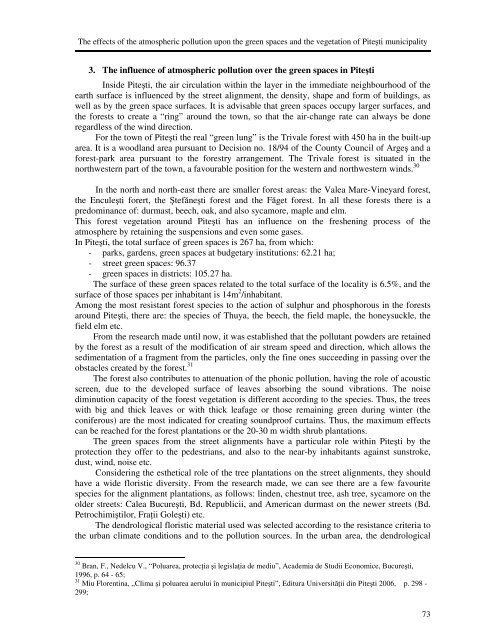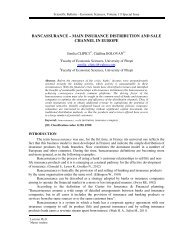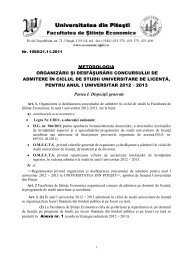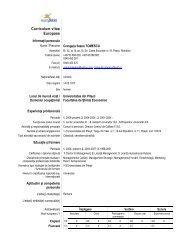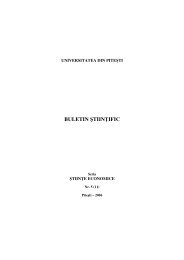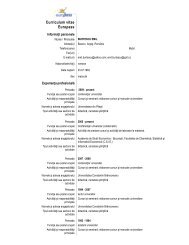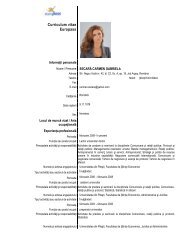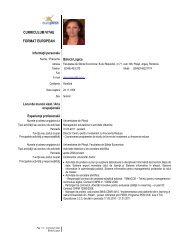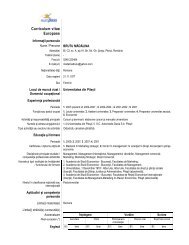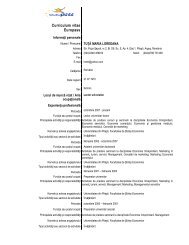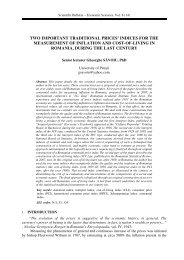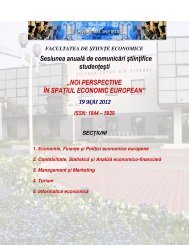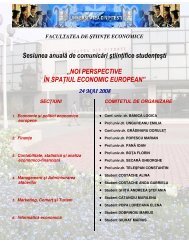buletin Åtiin ific - Facultatea de Stiinte Economice - Universitatea din ...
buletin Åtiin ific - Facultatea de Stiinte Economice - Universitatea din ...
buletin Åtiin ific - Facultatea de Stiinte Economice - Universitatea din ...
- No tags were found...
Create successful ePaper yourself
Turn your PDF publications into a flip-book with our unique Google optimized e-Paper software.
The effects of the atmospheric pollution upon the green spaces and the vegetation of Piteşti municipality3. The influence of atmospheric pollution over the green spaces in PiteştiInsi<strong>de</strong> Piteşti, the air circulation within the layer in the immediate neighbourhood of theearth surface is influenced by the street alignment, the <strong>de</strong>nsity, shape and form of buil<strong>din</strong>gs, aswell as by the green space surfaces. It is advisable that green spaces occupy larger surfaces, andthe forests to create a “ring” around the town, so that the air-change rate can always be doneregardless of the wind direction.For the town of Piteşti the real “green lung” is the Trivale forest with 450 ha in the built-uparea. It is a woodland area pursuant to Decision no. 18/94 of the County Council of Argeş and aforest-park area pursuant to the forestry arrangement. The Trivale forest is situated in thenorthwestern part of the town, a favourable position for the western and northwestern winds. 30In the north and north-east there are smaller forest areas: the Valea Mare-Vineyard forest,the Enculeşti forert, the Ştefăneşti forest and the Făget forest. In all these forests there is apredominance of: durmast, beech, oak, and also sycamore, maple and elm.This forest vegetation around Piteşti has an influence on the freshening process of theatmosphere by retaining the suspensions and even some gases.In Piteşti, the total surface of green spaces is 267 ha, from which:- parks, gar<strong>de</strong>ns, green spaces at budgetary institutions: 62.21 ha;- street green spaces: 96.37- green spaces in districts: 105.27 ha.The surface of these green spaces related to the total surface of the locality is 6.5%, and thesurface of those spaces per inhabitant is 14m 2 /inhabitant.Among the most resistant forest species to the action of sulphur and phosphorous in the forestsaround Piteşti, there are: the species of Thuya, the beech, the field maple, the honeysuckle, thefield elm etc.From the research ma<strong>de</strong> until now, it was established that the pollutant pow<strong>de</strong>rs are retainedby the forest as a result of the mod<strong>ific</strong>ation of air stream speed and direction, which allows thesedimentation of a fragment from the particles, only the fine ones succee<strong>din</strong>g in passing over theobstacles created by the forest. 31The forest also contributes to attenuation of the phonic pollution, having the role of acousticscreen, due to the <strong>de</strong>veloped surface of leaves absorbing the sound vibrations. The noisediminution capacity of the forest vegetation is different accor<strong>din</strong>g to the species. Thus, the treeswith big and thick leaves or with thick leafage or those remaining green during winter (theconiferous) are the most indicated for creating soundproof curtains. Thus, the maximum effectscan be reached for the forest plantations or the 20-30 m width shrub plantations.The green spaces from the street alignments have a particular role within Piteşti by theprotection they offer to the pe<strong>de</strong>strians, and also to the near-by inhabitants against sunstroke,dust, wind, noise etc.Consi<strong>de</strong>ring the esthetical role of the tree plantations on the street alignments, they shouldhave a wi<strong>de</strong> floristic diversity. From the research ma<strong>de</strong>, we can see there are a few favouritespecies for the alignment plantations, as follows: lin<strong>de</strong>n, chestnut tree, ash tree, sycamore on theol<strong>de</strong>r streets: Calea Bucureşti, Bd. Republicii, and American durmast on the newer streets (Bd.Petrochimiştilor, Fraţii Goleşti) etc.The <strong>de</strong>ndrological floristic material used was selected accor<strong>din</strong>g to the resistance criteria tothe urban climate conditions and to the pollution sources. In the urban area, the <strong>de</strong>ndrological30 Bran, F., Ne<strong>de</strong>lcu V., “Poluarea, protecţia şi legislaţia <strong>de</strong> mediu”, Aca<strong>de</strong>mia <strong>de</strong> Studii <strong>Economice</strong>, Bucureşti,1996, p. 64 - 65;31 Miu Florentina, „Clima şi poluarea aerului în municipiul Piteşti”, Editura Universităţii <strong>din</strong> Piteşti 2006, p. 298 -299;73


